
A look inside the market
So, we have just about everything that we need to know in order to make a quality, functional waterblock. We understand what it's doing, and we understand how. We even have some good rules to put into play.But nothing, and I mean nothing brings home a point quite like seeing it put to use. And because we're all curious enthusiasts but most of us don't have unlimited budgets, I figured I'd do you a favour and give you something that you probably can't do yourself.
Yep, it's time to tear open four of the world's best-performing waterblocks to give you a look inside. And when you're done, you may feel more confident about why you're going to spend that thirty quid... or, maybe you'll have learned enough to build your own.
So, let's take a closer look at these bad boys – I'm listing them here in alphabetical order, so nobody misconstrues this as a preference!
Aquacomputer Cuplex XT
Cost: £51.11 (inc. VAT)Nothing says 'sexy and thin' quite like quality German engineering. And one of the finest examples of this is the Aquacomputer Cuplex XT. The XT is the replacement for the incredibly popular Cuplex Evo, which was the premier "low flow" waterblock for quite some time.
It's a bit of a misnomer to say "low flow", as all blocks perform better with more water going through them – there's simply more liquid to absorb heat at any given time. But not everyone likes the look of 1/2" ID tubes, and making a block that can function almost as well with significantly less water is a difficult prospect.
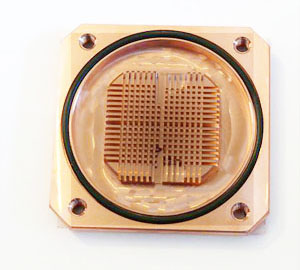
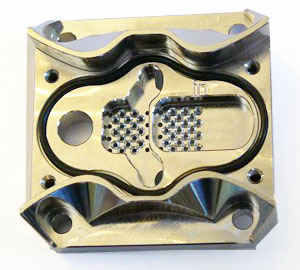
Left: The bottom plate of the Aquacomputer Cuplex XT; Right: The 'midsection' of the block.
When you look at the dissected block, look closely at the bottom plate. It's very thin, milled from about 1/4" thick plate of copper. The "fins" to increase surface area are arranged as a grid of spikes, allowing water to flow all the way around them. Note that they're only located in the centre of the block, over the CPU die – the edges are fairly smooth, allowing water to flow more easily and orderly out of the block.
The second picture is the block's midsection, directly below the Perspex top. Notice the output valve on the left, which is pulling water directly from the copper base. The input valve streams into the slot on the right and the water is forced down via the jets to create turbulence. This turbulent water sprays directly over the grid pattern of the copper below. Water that exits the grid below too quickly will be pushed back up through the centre section of this, and forced back down through another set of jets to cover the other half of the grid.
As you look at the block disassembled, do you notice a couple areas of extremely good design? For instance, notice the countersunk holes for the jet area – these will add a vortex effect to the water jets, providing added turbulence as the water flows to the copper below.
But there's also a bit that could be improved upon. Putting the inlet over the centre instead of on the right would decrease the resistance of the block – and water only moves as fast as the most restrictive part. This choice was probably done to increase the pressure, and provides some neat aesthetics.
However, in a system that's already low flow, pressure will tend to be higher already. And the centre set of jets? This type of addition slows water down even further. Sure, it can absorb more heat, but it also can't exit to get rid of that heat, either... and water will always take the path of least resistance, so much of your water will just travel through the copper base and out. All of this means a bigger, beefier pump to push with, which adds more intricacies and heat sources to the loop – possibly negating any gains.
Danger Den TDX
Cost: £34.99 (inc. VAT)Very few names are as synonymous with water as Danger Den, and there's good reason for that. Dan, the Oregon, USA madman of cooling has been designing waterblocks for years – and developed quite a following and reputation for quality.
The most current incarnation, the Danger Den TDX (This is the standard TDX, but there is also an MC-TDX - short for multi-core), is touted to be one of the best cooling solutions to date – period. And one look at the simple and elegant block design makes it clear that this thing means business.
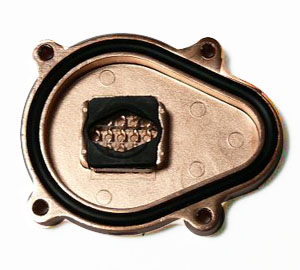
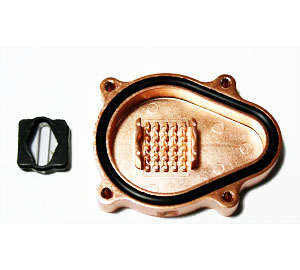
Left: The TDX without its polycarbonate cover; Right: The block after the nozzle is removed.
The TDX is an incredibly simple and ingenious design. Envision it as two circles side by side, one much smaller than the other. The centre of the big circle where the fins are sits directly over the CPU die, providing the surface area right where it's needed. Since the block is designed for much higher flow rates, it's considerably deeper so that it can hold more water. The water is guided out from below the jets by the walls on either side, bringing it to the edges of the block to flow out.
Speaking of jets, look at the nozzle placement. The inlet is directly over the fins, with a separate turbulence nozzle that is locked in place under the polycarbonate. This allows a very powerful stream down to the fins below, meaning that the boundary layer in this area is hardly likely to exist. Since all of the fins are directly under the nozzle, none of this surface area gets the opportunity to form a boundary layer – providing maximum cooling.
Once out of the finned section of the block, the edges are smoothed – but note the natural taper of the block to the smaller circle, which is the outlet. This helps reinstate laminar flow more quickly, meaning that already heated water does not waste time or energy bouncing around further in the block.
Now that we've covered what's right, how about what could be improved? Perhaps some of those fins could be twisted, providing yet more turbulence and an enhanced vortex effect, as is created by the countersinking in the Aquacomputer block. Also, some of the fins could be raised higher, providing a greater surface area while not cutting down on the water's ability to flow.
Would these provide a significant improvement? Maybe not, and likely not for the added cost – but we're not critiquing these blocks for the idea of company mass-production, we're just looking for things we could add to our own design.

MSI MPG Velox 100R Chassis Review
October 14 2021 | 15:04

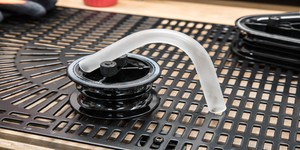






Want to comment? Please log in.